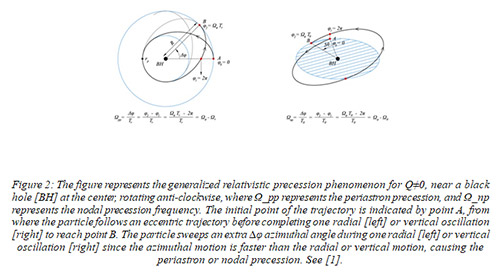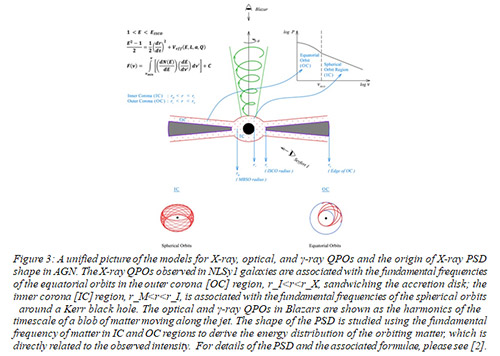 Particles in an ionized state of matter called plasma zip around at the outskirts of black holes; they partly fall into the black hole, and the rest escape in the form of jets. Scientists have developed a model that can help probe the nature of plasma processes in black hole systems that could include powerful jets.
Particles in an ionized state of matter called plasma zip around at the outskirts of black holes; they partly fall into the black hole, and the rest escape in the form of jets. Scientists have developed a model that can help probe the nature of plasma processes in black hole systems that could include powerful jets.
The understanding of the plasma processes close to a rotating black hole is an important puzzle in the field of black holes. The temperature of matter near a rotating black hole is very high, due to which the surrounding gas is ionized and in the plasma state. A model called the general relativistic precession model (GRPM) developed by Ms. Prerna Rana and Prof. A. Mangalam, from the Indian Institute of Astrophysics (IIA), an autonomous institute under the Department of Science & Technology (DST), Government of India, has been published in The Astrophysical Journal [1] and Galaxies [2]. The scientists also hint at the possibility of a geometric origin of the temporal light signatures or variations observed in the astrophysical black hole systems by mapping the motion of the plasma in the region very close to a rotating black hole. The likely candidates that produce the variations are the non-equatorial and eccentric orbits around the spinning black hole published in the Journal of Classical and Quantum Gravity [3].
 The GRPM developed by the IIA team suggests that the excitation of instabilities above the mean plasma flow causes nearly periodic fluctuations called the Quasi-periodic oscillations [QPOs]. As the motion of the plasma is governed by the background potential of the rotating black hole, this information also provides the estimates for the orbital parameters and spin of the black hole.
The GRPM developed by the IIA team suggests that the excitation of instabilities above the mean plasma flow causes nearly periodic fluctuations called the Quasi-periodic oscillations [QPOs]. As the motion of the plasma is governed by the background potential of the rotating black hole, this information also provides the estimates for the orbital parameters and spin of the black hole.
These models for the QPO frequencies propounds a geometric origin of these temporal signatures near a rotating black hole. It is expected that detailed GRMHD models will be useful for future numerical simulations probing the non-equatorial fluid flow. This will improve our understanding of the underlying physics and provide more precise estimates for the spin and mass of the black hole.

Publication details:
[1] Rana, P. and Mangalam A., A Geometric Origin for Quasi-periodic Oscillations in Black Hole X-ray Binaries, ApJ 2020, 903, 121. DOI: 10.3847/1538-4357/abb707
[2] Rana, P. and Mangalam A., A Relativistic Orbit Model for Temporal Properties of AGN, Galaxies 2020, 8(3), 67. https://doi.org/10.3390/galaxies8030067
[3] Rana, P. and Mangalam A., Astrophysically relevant bound trajectories around a Kerr black hole, Classical and Quantum Gravity 2019, 36, 045009. DOI: 10.1088/1361-6382/ab004c
For more details, Prof. Arun Mangalam (mangalam[at]iiap[dot]res[dot]in) can be contacted.






























